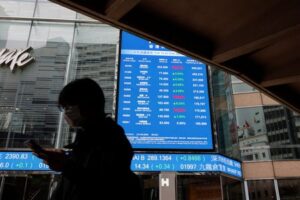By Chuck Mikolajczak and Vidya Ranganathan
NEW YORK (Reuters) -Japan’s currency surged as much as 5 yen against the dollar from a fresh 34-year low hit earlier on Monday, with traders citing yen-buying intervention by Japanese authorities for the first time in 18 months.
The outsized move and volatile trading throughout the day for the yen kicked off a busy week for traders, with the U.S. Federal Reserve capping off its two-day policy meeting on Wednesday, the U.S. jobs report on Friday, and European inflation data throughout the week, starting with Germany and Spain on Monday.
The dollar fell as far as 154.4 yen in several rapid moves that knocked it from an intraday high of 160.245, its highest since 1990, sparking speculation the Bank of Japan had intervened.
The greenback was last at 156.01 yen, down 1.47%. Trading in Asia was thinner than normal due to Japan’s Golden Week holiday. The dollar also saw another sharp decline shortly after midday, dropping from 156.495 to 155.05 in a span of six minutes.
“The timing actually makes sense because you’re going to have a thinner market, so they’re going to get more effect out of whatever they do and that’s why they chose to do it relatively early in the Asian market, they can push it around more,” said Joseph Trevisani, senior analyst at FX Street in New York.
Japan’s top currency diplomat Masato Kanda declined to comment when asked if authorities had intervened, though traders said they had and the Wall Street Journal said Japanese authorities had intervened, citing people familiar with the matter.
Markets had been anticipating that Japan might intervene to prop up the yen after the currency fell more than 10% against the dollar this year.
“When any central bank starts to intervene, it does put traders on watch. It makes traders rethink the sizing of their position,” said Nate Thooft, chief investment officer and senior portfolio manager, Multi-Asset Solutions Team at Manulife Investment Management in Boston.
“Just the fact they may now be intervening probably does cause some pause among the market makers and the traders that have been on the side of a weaker yen to be able to basically downsize their risk exposure and/or take some chips off the table because they’ve been right … it helps the BOJ achieve what they want to achieve.”
The Commodity Futures Trading Commission’s weekly commitments of traders report showed that non-commercial traders, a category that includes speculative trades and hedge funds, had increased their yen short positions to 179,919 contracts in the week ended April 23, the largest since 2007.
The yen had weakened sharply on Friday after the Bank of Japan kept policy settings unchanged and offered little insight into the reduction of its Japanese government bond purchases.
Japan’s suspected intervention by the central bank comes ahead of the Fed’s May 1 policy announcement, with markets widely expecting the U.S. central bank will keep interest rates unchanged, according to CME’s FedWatch Tool, given the solid labor market and recent inflation data that was hotter than anticipated.
Investors have continually had to dial back expectations for the timing and magnitude of U.S. rate cuts this year, and the divergence in policy stances from the Bank of Japan and the Fed have fueled the yen weakness.
“Over time with this interest differential between the BoJ and the Fed and the obvious reluctance of the BoJ to do anything about that, to change their decades-old policy, now essentially zero interest rates, it’s tough to build up any momentum for the Japanese yen going the other way to strengthen,” said Trevisani.
In addition, other major central banks such as the European Central Bank and the Bank of England are seen as more likely to begin to cut rates in the near future.
The dollar index fell 0.31% to 105.63, with the euro up 0.25% at $1.0719. Sterling strengthened 0.54% to $1.2558.
European inflation data this week will help shape the path of interest rates for the ECB. Spain’s European Union-harmonized inflation rate stood at 3.4% in the 12 months through April, up from 3.3%. Data from Germany showed inflation rose slightly in April due to higher food prices and a smaller drop in energy prices.
(Reporting by Chuck Mikolajczak; additional reportingh by Sinéad Carew in New York, Alun John in London and Vidya Ranganathan in Singapore)





